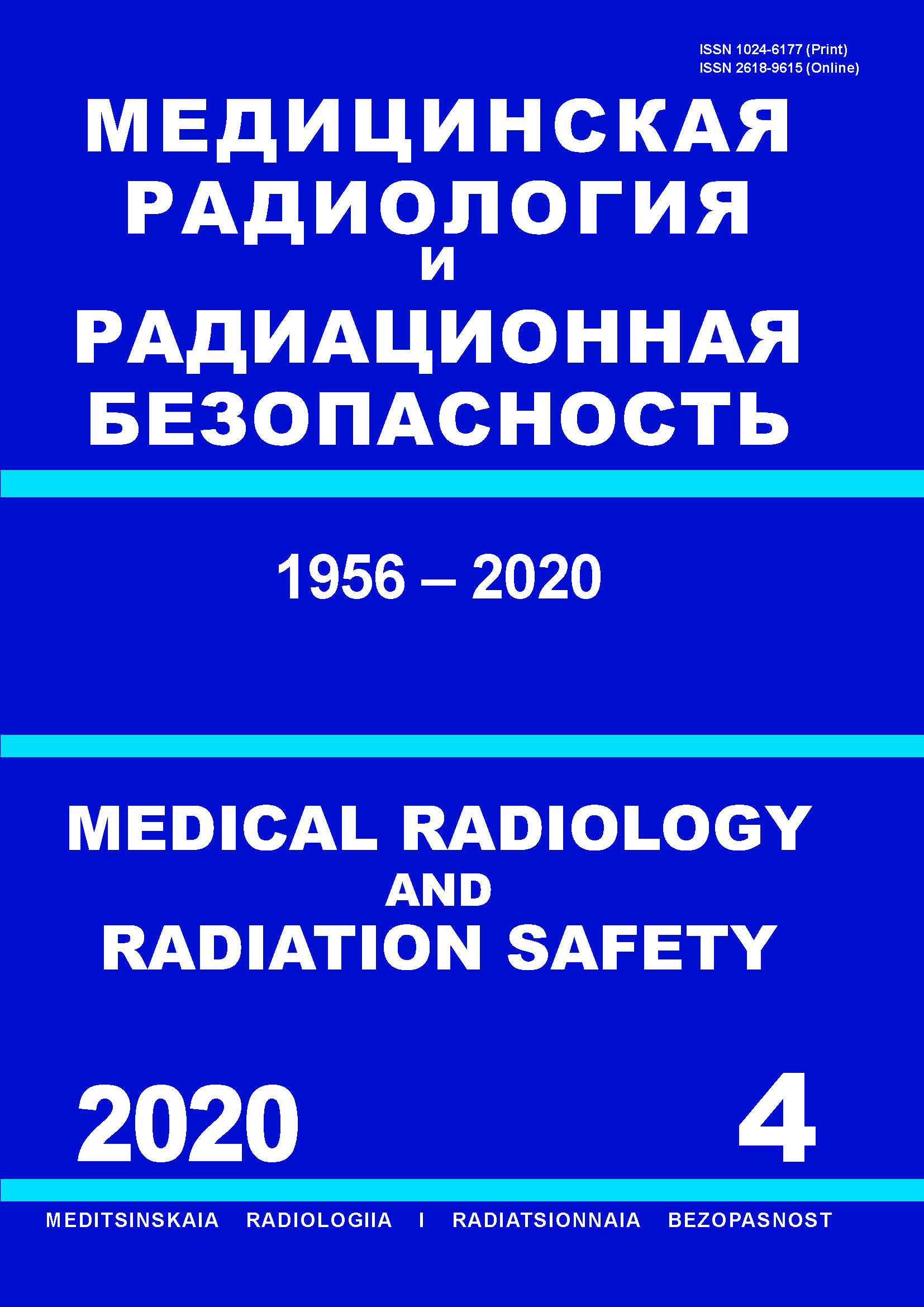VAK Russia 14.02.2004
VAK Russia 14.03.2000
UDC 61
CSCSTI 76.03
CSCSTI 76.13
CSCSTI 76.29
CSCSTI 76.35
Russian Classification of Professions by Education 31.06.2001
Russian Classification of Professions by Education 31.08.71
Russian Classification of Professions by Education 31.07.01
Russian Library and Bibliographic Classification 511
Russian Library and Bibliographic Classification 53
Russian Library and Bibliographic Classification 54
Russian Library and Bibliographic Classification 56
Russian Library and Bibliographic Classification 57
Russian Library and Bibliographic Classification 58
Russian Trade and Bibliographic Classification 5706
Russian Trade and Bibliographic Classification 5734
BISAC MED080000 Radiology, Radiotherapy & Nuclear Medicine
Purpose: To assess the contribution of low doses of diagnostic radiation due to computed tomography to carcinogenic risk among population of Ozersk. Material and methods: The study describes the results of the analysis of data from the radiation-epidemiological register created in the laboratory of radiation epidemiology of the Southern Urals Biophysics Institute of Ozersk. The register contains information on 26,626 CT examinations of Ozersk residents of all age groups, including children under 1 year old, carried out in medical departments of the Chelyabinsk region during the period from 1993 to 2018. Results: Based on the analyzed medical and dosimetric information from the CT Register database, the chances of malignant neoplasms among patients exposed to diagnostic irradiation during computed tomography were assessed taking into account the presence of the main radiation and non-radiation factors (age, sex, occupational exposure, number of CT examinations, effective dose and DLP). Conclusion: In a cohort of Ozersk residents who were exposed to low doses of diagnostic radiation during computed tomography, a statistically significant effect of sex and age attained to malignant neoplasm was obtained. Also, a significant relationship was found between the effective dose from diagnostic CT and the likelihood of subsequent cancer development diagnosed no earlier than 2 years after the first CT examination. At the same time, the DLP did not statistically significantly increase the chances of developing a malignant neoplasm in the study cohort for both the population and the personnel of the Mayak PA.
medical exposure, computed tomography, diagnostic exposure, occupational exposure, low doses, cancer, radiogenic risk
1. Shultz CH, Fairley R, Murphy L, Doss M. The risk of cancer from CT scans and other sources of low-dose radiation:a critical appraisal of methodologic quality. Prehospital and Disaster Medicine. 2020;35(1):3-16. DOI:https://doi.org/10.1017/S1049023X1900520X.
2. Stanton A. Glantz. Primer of Biostatistics. Seventh Edition. The McGrow-Hill Medical, 2012. 327 p.
3. Rȕhm W, Harrison RM. High CT doses return to the agenda. Radiat Environ Biophys. 2020;59:3-7. DOI:https://doi.org/10.1007/s00411-019-00827-9.
4. Koshurnikova NA, Shilnikova NS, Okatenko PV, Kreslov VV, et al. Characteristics of the cohort of workers at the Mayak nuclear complex . Radiat Res. 1999;152(4):352-63.
5. Fomin EP, Osipov MV. Pooled database of Ozyorsk population exposed to computed tomography. REJR. 2019;9(2):234-9. DOI:https://doi.org/10.21569/2222-7415-2019-9-2-234-239.
6. Control of effective doses to patients during medical x-ray studies: guidelines. M.: Federal Center for Hygiene and Epidemiology of Rospotrebnadzor. 2011. 38 p. (In Russ.)].
7. Koshurnikova NA, Kabirova NR, Bolotnikova MG, et al. Characteristics of the register of persons living in childhood near PA Mayak. Medical Radiology and Radiation Safety. 2003;2:27-34. (In Russ.)].
8. Guidance on coding of causes of death. Ed. Leonov S.A. Moscow. 2008. 74 p. (In Russ.)].
9. United Nations Scientific Committee on the Effects of Atomic Radiation. Sources and effects of ionizing radiation: United Nations Scientific Committee on the Effects of Atomic Radiation: UNSCEAR 2012 report to the General Assembly. Scientific Annexes. New York United Nations. 2015. 320 p.
10. Osipov MV, Sokolnikov ME. Problems of assessing the carcinogenic risk of medical exposure in a cohort of personnel of a nuclear industrial complex enterprise. Medical Radiology and Radiation Safety. 2015;60(6):60-6. (In Russ.)].
11. Osipov MV, Sokolnikov ME. A previous malignant neoplasm as a risk factor for a second cancer in a cohort of employees of a nuclear industrial complex enterprise. Russian Oncological Journal. 2016;21(4):190-4 (In Russ.)].
12. Kohler U, Kreute F. Data analysis using Stata. USA, Texas. Statapress. 2005. 378 p.
13. Hosmer D, Lemeshev S. Applied Logistic Regression. Second Edition. Wiley, New York. 2000. 392 p.
14. Osipov MV, Sokolnikov ME. Computed tomography as a factor of radiation risk in the population of Ozersk in the period 1993-2004. Diagnostic and Interventional Radiology. 2020;14(2):20-7. (In Russ.)].
15. Bernier M, Baysson H, Pearce M, et al. Cohort Profile: the EPI CT study: a European pooled epidemiological study to quantify the risk of radiation-induced cancer from pediatric CT. Int J Epidemiol. 2019;48(2):379-81. DOI:https://doi.org/10.1093/ije/dyy231.
16. Meulepas J M, Ronckers C M, Smets A, et al. Radiation Exposure From Pediatric CT Scans and Subsequent Cancer Risk in the Netherlands. J Natl Cancer Inst. 2019;111(3):256-63. DOI:https://doi.org/10.1093/jnci/djy104.
17. Thierry-Chef I, Dabin J, Friberg EG, et al. Assessing Organ Doses from Paediatric CT Scans - A Novel Approach for an Epidemiology Study (the EPI-CT Study). Int J Environ Res. Public Health. 2013;10:71728. DOI:https://doi.org/10.3390/ijerph10020717.
18. Shao Yu-H, Tsai K, Kim S, et al. Exposure to Tomographic Scans and Cancer Risks. JNCI Cancer Spectrum. 2020;4(1):72.
19. Pearce MS, Salotti JA, Little MP, et al. Radiation exposure from CT scans in childhood and subsequent risk of leukaemia and brain tumors: a retrospective cohort study. Lancet. 2012;380:499-505.
20. Osipov MV, Vazhenin AV, Domozhirova AS, Chernova ON, Aksenova IA. Computed tomography as a risk factor in cancer patients with occupational exposure. REJR. 2019;9(1):142-7. DOI:https://doi.org/10.21569/2222-7415-2019-9-1-142-147.
21. Osipov M, Vazhenin A, Kuznetsova A, Aksenova I, Vazhenina D, Sokolnikov M. PET-CT and Occupational Exposure in Oncological Patients. SciMedicine Journal. 2020;2(2):63-9. DOI:https://doi.org/10.28991/SciMedJ-2020-0202-3.





